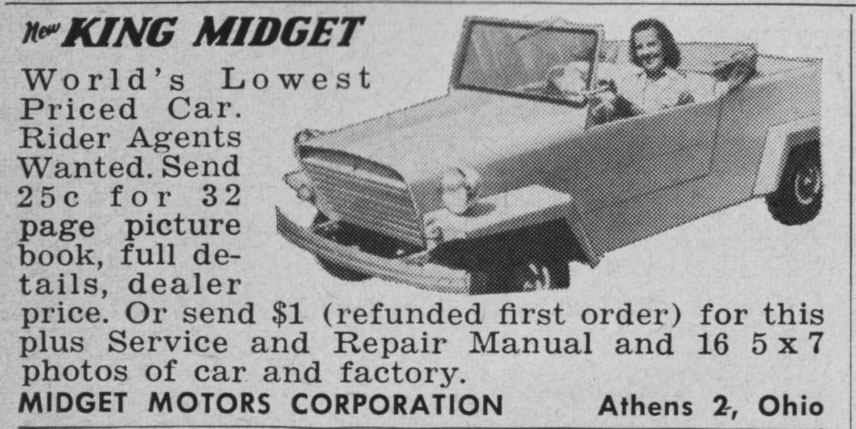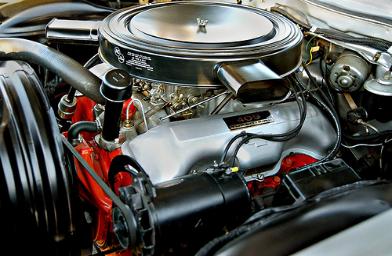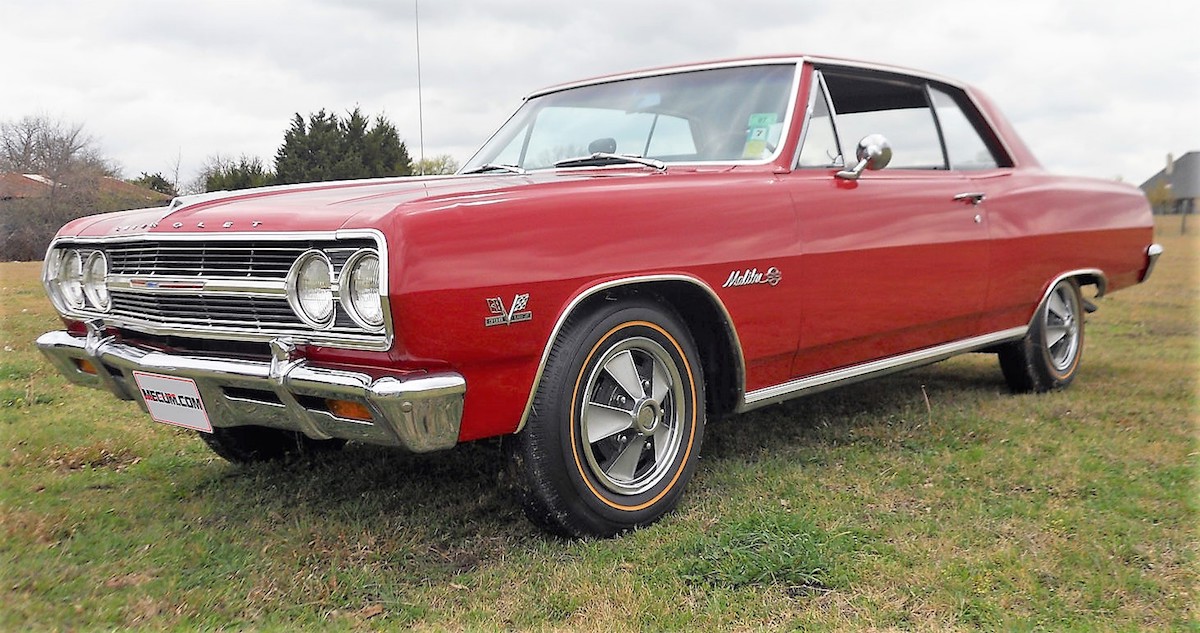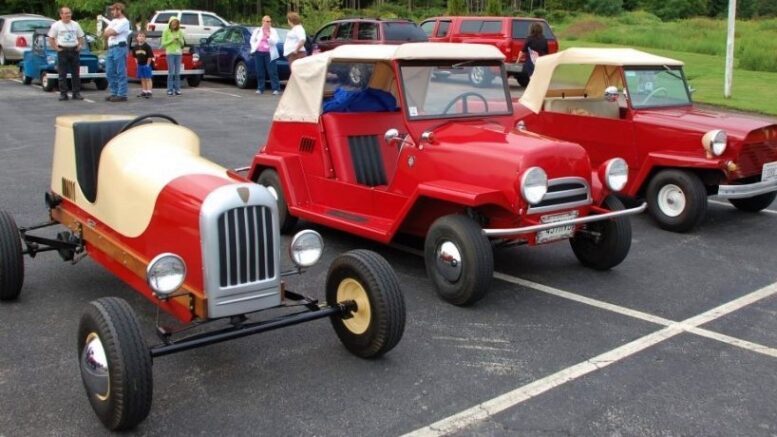King Midgets still live
Q: Greg, could you please tell your readers about a micro sub-compact car called the King Midget? I always felt they were kind of like a larger go-kart that you could actually drive on the street and have it registered. Bill L., Rhode Island.
A: Happy to oblige, Bill. Back in 1946 after World War II, two ingenious Americans came up with a single-cylinder-powered roadster in micro kit car form called “King Midget.” The inventors were Claude Dry and Dale Orcutt, former Civil Air Patrol pilots. For only the $270, consumers received a single-seat automobile that was styled like the midget racecars that were booming in popularity across the country. Produced until 1970 by the Midget Motors Corporation, the King Midget inventors started by offering a kit car but soon added completely assembled cars and finally completed cars only.
Unlike the real Midget racecars, the King Midget developed only 6-horsepower from its one-cylinder engine and they were street legal with small eight-inch tires. King Midget’s engine started similar to that of a lawn mower, ala give it a good yank and stand back!

Ad that appeared in Popular Mechanics and Popular Science magazines of the first King Midget, which looked like a Midget Race car. Later King Midgets had room for two, and were completely restyled. (King Midget Photos)
The second generation came in 1951 in kit or assembled form and cost about $560, double the price of the first series, and featured seating for two. Produced until 1956, these roadsters were slightly more usable in that they featured a convertible top and a little bit of extra power. The style also changed, going from Midget Race car appearance to a “Jeepster” or “VW Thing” style. In its third generation starting production in 1957, the King Midget gained aluminum and steel doors, and grew from 102 inches to 117 inches in length. The horsepower increased to 10.
Since no dealers existed for the mail order midget, buyers who passed on word-of-mouth advertising resulting in a sale received a commission. The King Midget also sold well thanks to print ads in Popular Mechanics and Popular Science magazines, one of which I saw and nearly ordered back in 1966.
The 1969 / 1970 King Midget was the best of the bunch in its final upgrade. The engine switched from a Wisconsin single-cylinder engine to a Kohler engine that produced 12 horsepower. These King Midgets could reach 50-mph because it weighed only about 695 pounds. They also average about 60-miles-per-gallon.
The final 1970 Midget runs on a 76.5-inch wheelbase and is actually a 1969 built model, which was its final year and sold through 1970. It offered options like deluxe trim, better doors, speedometer, turn signals, windshield wipers and seatbelts.
In 1966, Dry and Orcutt sold the business, but the new owners ran it into bankruptcy in 1969. A third owner tried to revive the car in 1970, but the effort failed.
Today, King Midgets are popular on the collectible market as an “estimated guess” of only 5,000 were ever built. No official records were kept, so no one is really sure.
That final King Midget cost approximately $890 in 1969, but I should note that Barrett-Jackson sold a pristine example for over $14,000 a while back and the third generation King Midget is listed at a low retail of $4,900 to a high retail of $16,500 by NADA Classic Car Values.
In ending, those interested in the King Midget should consider membership in the International King Midget Car Club, Inc. (kingmidgetcarclub.org) and you’ll receive a King Midget newsletter and be informed of their Jamborees and special promotions. Noteworthy is the club just held its Annual 2022 Jamboree in Wichita, Kansas, Aug. 11-13.
She’s real fine my 409
Q: I am a lover of the Chevy 409, which was a powerhouse in 1962, 1963, and 1964 in the Chevy lineup. However, did the 409 come in any cars in 1965? Albert M. retired in Florida.

The 409 engine, top, shows a “W’ head design (pictured), which is much different looking than the 1963 427 Mark IV engine with larger cylinder heads. (Chevrolet Motor Division Photos)
A: Albert, the Chevy 409 was indeed available through mid-1965 in the large Chevy line. Here’s the history on the big Chevy engines, including the 409’s successor, the 396.
The first ever production big block Chevy is called the “W” series, available in either 348 or 409 inches. I always felt the valve covers resembled an upside down “W” (see photo), which I guess could also have been called an “M” series. Chevy, meanwhile, had no hidden reason to call it a “W” series.
My friend’s brother had a 1958 Impala with the first high performance “W” 348 with three two-barrel carbs, and the car ran very well. Originally intended for truck use, the 348, which lasted from 1958 to 1961 in cars and 1964 in trucks, would then grow into the 409 that you and millions of others came to love. (Yes, me too.)
From the outside, the 348 and 409 engines look identical, as both had the “W” head design. The heads, incidentally, had no combustion chambers as they were adapted into the actual block design and didn’t breathe well at high rpm. The 409 was produced from 1961 to 1965 and ranged in horsepower ratings from its entry 360 in 1961 to a dual quad 425-horse in 1963. However, there was another very limited edition “W” series called the Z11 427 engine that debuted in 1963 and was given to drag racers and those who knew of the Z11 nomenclature at the Chevy dealer. This engine produced a very conservative 430 horsepower, and less than 60 engines were ever built.
I still remember the day in 1976 when I purchased a 1963 409-425 complete for $25 from Burris Auto Parts in Vineland, N.J. I remember I had the guys at the junkyard put the 409 into the trunk of my 1962 Plymouth Savoy, and it was sinking really low in the back all the way home.
Sadly, I let it go for exactly the same amount of money when I found it had more internal damage than I wanted to deal with. (Read that not enough money.) Had I kept that engine, the intake and two four-barrel carbs would be worth over $2,000 today!
By mid-1965, the 409 was on the outs as Chevy perfected its first Mark IV 396-427 big block “Mystery” style engine that debuted at the Daytona 500 in 1963. The cylinder heads on the Mark IV big block had large combustion chambers and canted valves that resulted in a great deal more horsepower. It debuted as a 396 inch V8 putting out 425 horses in 1965 in the Corvette and a very limited number in the ’65 Chevelle SS line, rated at 375 horses (same motor but with a hydraulic cam). This new 396 Mark IV engine would go on to similar 409 fame, sans the Beach Boys hit song, and grow to a 402-427-454 along the way. If you ordered a heavy-duty truck, you got one with a smaller 366 inch big block. By 1966, the Chevelle SS 396 was a top seller and crowded boulevards everywhere in America.

The ultra-rare 1965 Chevrolet Chevelle SS code Z16 was offered late in the year with a 396 big block putting out 375 horses with a hydraulic cam. Only 201 were ever built and they are worth big dollars today. (Chevrolet)
In summary and for some trivia, 1965 is the only year Chevy offered two different design big block production engines, a 409 and a 396 and there were five Mark IV big blocks available, as many forget the aforementioned 366 truck engine and the non-promoted 402, available from late 1968 as the standard engine on the SS396 line.
Thanks for your letter Albert.
(Greg Zyla is a syndicated auto columnist who welcomes reader questions or comments of collector cars, auto nostalgia and motorsports at greg@gregzyla.com.)




Be the first to comment on "Cars We Remember / Collector Car Corner; From small to large: The King Midget and Chevy big-block engine history"